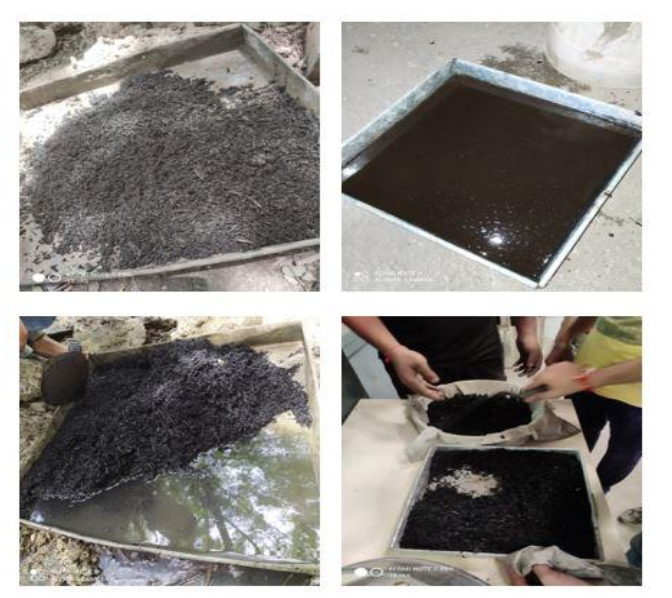Effect of Micro-silica and Crumb Rubber on Mechanical Properties of Concrete
Keywords:
silica fume , crumb rubber , pre-treatment of crumb rubber, rubberized concrete, cementitious materialsAbstract
Several researches conducted on rubberized concrete in the past but very few researchers explained the bonding effect of the waste tire rubber particles with different cementitious materials. In this research the effect of the fineness of the micro silica and its bonding with the rubber particles is studied. To check the influence of fractional replacement of cement using micro silica and discarded tire rubber as limited substitution of sand with providing pre-treatment to rubber particles, this experimental investigation has been conducted on concrete with varying percentage switch of cement using micro silica (SF), especially micro-silica was used in this study to exchange with cement by its weight. SF exchanged cement from 0% to 12% with an incremental ratio of 3%. Along with this, the sand was fractionally replaced using pretreated crumb rubber (CR) particles derived from end-of-life tires. The replacement ratio changed by 5% by the volume of sand, ranging from 0% to 20%. The pre-treatment process for CR was done using Sodium Hydroxide (NaOH) of 1 Molarity, for achieving good bonding between cementitious material paste and rubber particles. Distinct fresh and hydrated concrete properties were assessed and compared with normal concrete (NC) having 0% SF and 0% CR. 17 concrete mixtures in all, together with the control mix, were assessed in this study with varying amounts of SF and CR. The bonding structure and impermeability were enhanced by using SF in concrete with promising enhancement in mechanical strengths. Based on the outcomes obtained from this research, the optimal proportion for partial substitution of cement and sand by SF and CR was fixed for the desired grade of concrete to provide an innovative form of concrete to the construction industry.
References
U. Waghe, D. Agrawal, K. Ansari, M. Wagh, M. Amran, B. T. Alsulami, H. M. Maqbool, Y. Gamil, “Enhancing eco-concrete performance through synergistic integration of sugarcane, metakaolin, and crumb rubber: Experimental investigation and response surface optimization,” J. Eng. Res., no. June, 2023, doi: 10.1016/j.jer.2023.09.009.
D. Agrawal, U. P. Waghe, S. P. Raut, M. D. Goel, and P. Ruchika, “Performance of Geopolymer Concrete - A Critical Review,” In: Ranadive, M.S., Das, B.B., Mehta, Y.A., Gupta, R. (eds) Recent Trends in Construction Technology and Management. Lecture Notes in Civil Engineering, vol 260, 2023, doi: 10.1007/978-981-19-2145-2_3.
E. Ganjian, G. Jalull, and H. Sadeghi-pouya, “Using waste materials and by-products to produce concrete paving blocks,” Constr. Build. Mater., vol. 77, pp. 270–275, 2015, doi: 10.1016/j.conbuildmat.2014.12.048.
A. Namdar and X. Feng, “Economical considerations in the development of construction materials - A review,” Eng. Rev., vol. 35, no. 3, pp. 291–297, 2015.
Z. Narimane, Z. Hamma, J. P. Castro-Gomes, B. Boudjema, T. Aissa, and B. M. Amin, “Evolution of durability and mechanical properties of ordinary Portland cement concretes in sulphates attack,” Eng. Rev., vol. 40, no. 3, pp. 32–41, 2020, doi: 10.30765/er.40.3.04.
D. Agrawal et al., “Optimization of eco-friendly concrete with recycled coarse aggregates and rubber particles as sustainable industrial byproducts for construction practices,” Heliyon, vol. 10, no. 4, p. e25923, 2024, doi: 10.1016/j.heliyon.2024.e25923.
S. Anıl, H. Yazıcı, H. Yig, and B. Baradan, “Utilization of fly ash and ground granulated blast furnace slag as an alternative silica source in reactive powder concrete,” vol. 87, pp. 2401–2407, 2008, doi: 10.1016/j.fuel.2008.03.005.
D. King and U. Kingdom, “The Effect of Silica Fume on The Properties of Concrete As Defined in Concrete Society Report 74 , Cementitious Materials The Effect of Silica Fume on The Properties of Concrete as Defined in Concrete Society Report 74 , Cementitious Materials,” 2012.
S. Engineering and J. Mallick, “Effect of Silica Fume on Steel Slag Concrete Effect of Silica Fume on Steel Slag,” 2010.
A. K. Dash, “Effect of Pozzolanas on Fiber Reinforced Concrete Master of Technology Reinforced Concrete,” 2010.
M. I. Khan and R. Siddique, “Utilization of silica fume in concrete: Review of durability properties,” Resour. Conserv. Recycl., vol. 57, pp. 30–35, 2011, doi: 10.1016/j.resconrec.2011.09.016.
K. K. Sahoo, P. Sarkar, and R. Davis, “Mechanical properties of silica fume concrete designed as per construction practice,” Proc. Inst. Civ. Eng. Constr. Mater., vol. 172, no. 1, pp. 20–28, 2019, doi: 10.1680/jcoma.16.00085.
M. Khan and M. Ali, “Improvement in concrete behavior with fly ash, silica-fume and coconut fibres,” Constr. Build. Mater., vol. 203, pp. 174–187, 2019, doi: 10.1016/j.conbuildmat.2019.01.103.
H. Sasanipour, F. Aslani, and J. Taherinezhad, “Effect of silica fume on durability of self-compacting concrete made with waste recycled concrete aggregates,” Constr. Build. Mater., vol. 227, p. 116598, 2019, doi: 10.1016/j.conbuildmat.2019.07.324.
O. Onuaguluchi and D. K. Panesar, “Hardened properties of concrete mixtures containing pre-coated crumb rubber and silica fume,” J. Clean. Prod., vol. 82, pp. 125–131, 2014, doi: 10.1016/j.jclepro.2014.06.068.
M. Elchalakani, “High strength rubberized concrete containing silica fume for the construction of sustainable road side barriers,” Structures, vol. 1, pp. 20–38, 2015, doi: 10.1016/j.istruc.2014.06.001.
M. Fakhri and F. Saberik, “The effect of waste rubber particles and silica fume on the mechanical properties of Roller Compacted Concrete Pavement,” J. Clean. Prod., vol. 129, pp. 521–530, 2016, doi: 10.1016/j.jclepro.2016.04.017.
T. Gupta, R. K. Sharma, and S. Chaudhary, “Impact resistance of concrete containing waste rubber fi ber and silica fume,” Int. J. Impact Eng., vol. 83, pp. 76–87, 2015, doi: 10.1016/j.ijimpeng.2015.05.002.
T. Gupta, S. Chaudhary, and R. K. Sharma, “Mechanical and durability properties of waste rubber fiber concrete with and without silica fume,” J. Clean. Prod., vol. 112, pp. 702–711, 2015, doi: 10.1016/j.jclepro.2015.07.081.
B. S. Mohammed, A. B. Awang, S. S. Wong, and C. P. Nhavene, “Properties of nano silica modified rubbercrete,” J. Clean. Prod., vol. 119, pp. 66–75, 2016, doi: 10.1016/j.jclepro.2016.02.007.
N. N. Hilal, “Hardened properties of self-compacting concrete with different crumb rubber size and content,” Int. J. Sustain. Built Environ., vol. 6, no. 1, pp. 191–206, 2017, doi: 10.1016/j.ijsbe.2017.03.001.
C. M. Copetti, P. M. Borges, J. Z. Squiavon, S. R. da Silva, and J. J. de Oliveira Andrade, “Evaluation of tire rubber surface pre-treatment and silica fume on physical-mechanical behavior and microstructural properties of concrete,” J. Clean. Prod., vol. 256, 2020, doi: 10.1016/j.jclepro.2020.120670.
O. Onuaguluchi and D. K. Panesar, “Hardened properties of concrete mixtures containing pre-coated crumb rubber and silica fume,” J. Clean. Prod., vol. 82, pp. 125–131, 2014, doi: 10.1016/j.jclepro.2014.06.068.
F. Pelisser, N. Zavarise, T. A. Longo, and A. M. Bernardin, “Concrete made with recycled tire rubber: Effect of alkaline activation and silica fume addition,” J. Clean. Prod., vol. 19, no. 6–7, pp. 757–763, 2011, doi: 10.1016/j.jclepro.2010.11.014.
J. Xie et al., “Combination effects of rubber and silica fume on the fracture behaviour of steel-fibre recycled aggregate concrete,” Constr. Build. Mater., vol. 203, pp. 164–173, 2019, doi: 10.1016/j.conbuildmat.2019.01.094.
IS 12269, “IS (Indian Standard). 2013. Ordinary Portland Cement, 53 Grade — Specification. IS 12269-13,” IS 12269, vol. 6, no. 2, pp. 141-142+144, 2013.
IS 2386 Part 3, “Methods Of Test For Aggregates For Concrete Specific Gravity, Density, Voids, Absorption And Bulking,” IS 2386 Part 3-2016, New Delhi, India, vol. 2386 Part, no. October 1963, pp. 1–19, 1963.
IS 383, “Coarse and fine aggregate for concrete - Specification,” Bur. Indian Stand. IS 383 -2016, New Delhi, India, no. January, pp. 1–18, 2016.
IS 2386- Part 1, “Method of test for aggregate for concrete. Part I - Particle size and shape.,” BIS2386- Part I, p. (Reaffirmed 2002), 1963.
IS 9103, “Concrete Admixtures- Specifications,” Bur. Indian Stand. New Delhi, India, no. April, 1999.
BIS 15388, “Silica Fume-Specification,” BIS 15388, pp. 1–13, 2003.
IS 2386 Part 4, “Methods of test for Aggregates for Concrete,IS 2386 part 4 : Mechanical properties,” IS 2386 Part 4 New Delhi, pp. 1–37, 1963.
ASTM: C138/C138M-13, “Standard Test Method for Density (Unit Weight), Yield, and Air Content (Gravimetric),” ASTM Int., vol. i, pp. 23–26, 2013, doi: 10.1520/C0138.
IS 1199 Part 3, “IS 1199 Part 3 Determination of Density of Fresh Concrete IC Fresh Concrete,” IS 1199 Part 3, vol. 1199, no. December, 2018.
IS 516, “Hardened concrete - Methods of test,” IS 516-2021, New Delhi, India, vol. 54, no. August, pp. 1–20, 2021, [Online]. Available: www.standardsbis.in
IS 1199 Part 5, “Fresh Concrete-Methods of Sampling, Testing and Analysis Part 5 Making and Curing of Test Specimens ( First Revision ),” IS 1199 Part 5-2018, New Delhi, India, vol. 1199, no. December, 2018, [Online]. Available: www.standardsbis.in
IS 5816, “Specification for splitting tensile strength of concrete -Method of Test,” IS 5816-1999, New Delhi, India, pp. 1–8, 1999.
D. Agrawal, “Experimental effect of pre-treatment of rubber fibers on mechanical properties of rubberized concrete,” J. Mater. Res. Technol., vol. 23, pp. 791–807, 2023, doi: 10.1016/j.jmrt.2023.01.027.
F. Abbassi and F. Ahmad, “Behavior analysis of concrete with recycled tire rubber as aggregate using 3D-digital image correlation,” J. Clean. Prod., vol. 274, p. 123074, 2020, doi: 10.1016/j.jclepro.2020.123074.

Downloads
Published
How to Cite
Issue
Section
License

This work is licensed under a Creative Commons Attribution-NonCommercial-NoDerivatives 4.0 International License.








